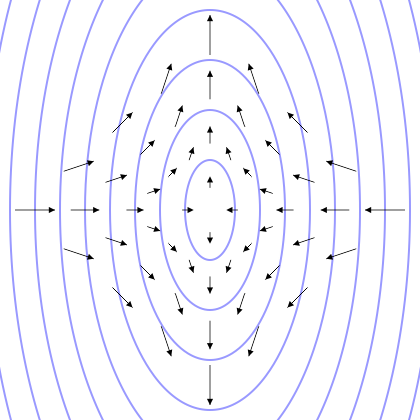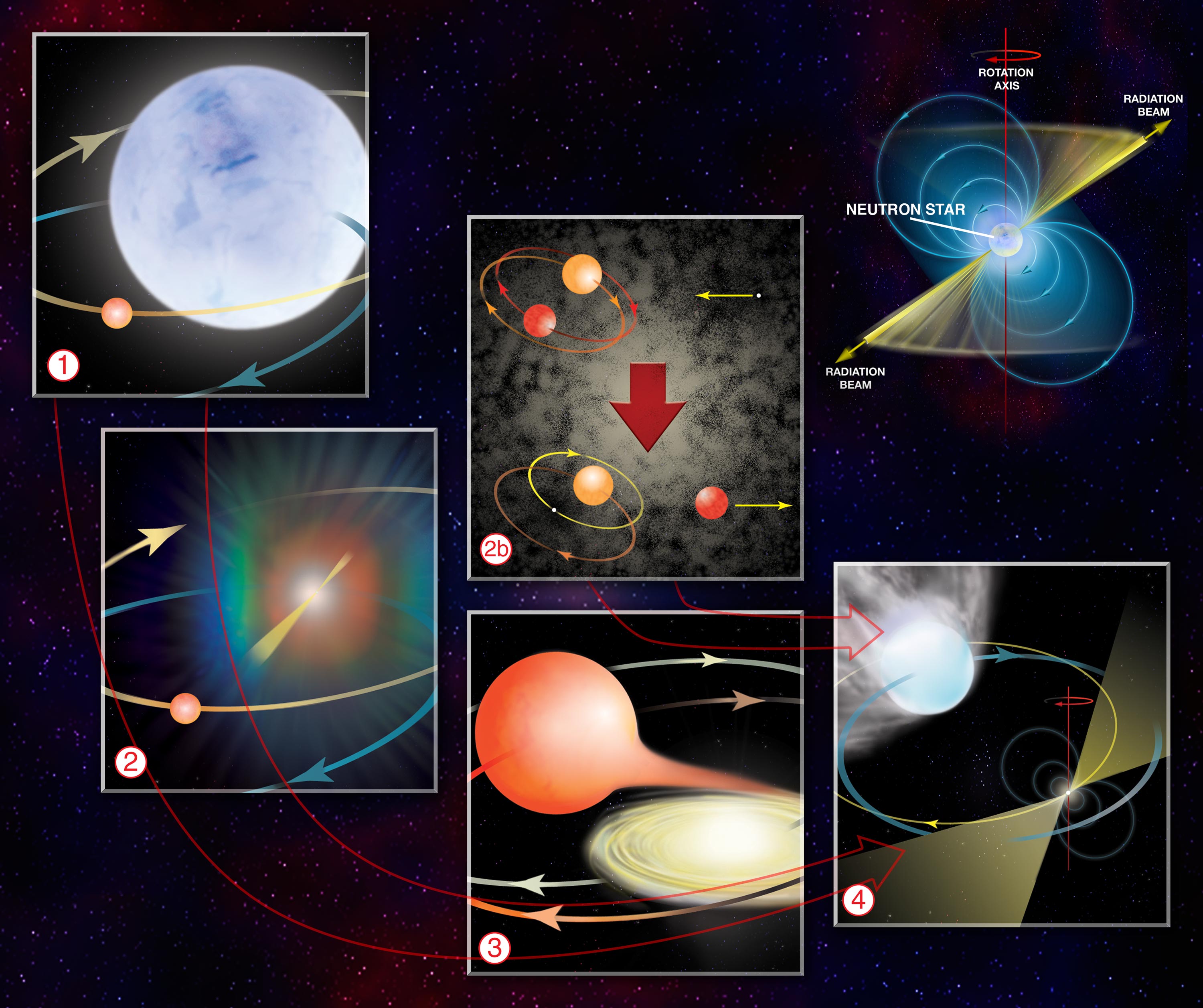|
NANOGrav
The North American Nanohertz Observatory for Gravitational Waves (NANOGrav) is a consortium of astronomers who share a common goal of detecting gravitational waves via regular observations of an ensemble of millisecond pulsars using the Green Bank Telescope, Arecibo Observatory, the Very Large Array, and the Canadian Hydrogen Intensity Mapping Experiment (CHIME). Future observing plans include up to 25% total time of the Deep Synoptic Array 2000. This project is being carried out in collaboration with international partners in the Parkes Pulsar Timing Array in Australia, the European Pulsar Timing Array, and the Indian Pulsar Timing Array as part of the International Pulsar Timing Array. Gravitational wave detection using pulsar timing Gravitational waves are an important prediction from Einstein's general theory of relativity and result from the bulk motion of matter, fluctuations during the early universe, and the dynamics of space-time itself. Pulsars are rapidly rotating, h ... [...More Info...] [...Related Items...] OR: [Wikipedia] [Google] [Baidu] |
Gravitational Wave
Gravitational waves are oscillations of the gravitational field that Wave propagation, travel through space at the speed of light; they are generated by the relative motion of gravity, gravitating masses. They were proposed by Oliver Heaviside in 1893 and then later by Henri Poincaré in 1905 as the gravitational equivalent of Electromagnetic radiation, electromagnetic waves. In 1916, Albert Einstein demonstrated that gravitational waves result from his general theory of relativity as ripples in spacetime. Gravitational waves transport energy as gravitational radiation, a form of radiant energy similar to electromagnetic radiation. Newton's law of universal gravitation, part of classical mechanics, does not provide for their existence, instead asserting that gravity has instantaneous effect everywhere. Gravitational waves therefore stand as an important relativistic phenomenon that is absent from Newtonian physics. Gravitational-wave astronomy has the advantage that, unlike elec ... [...More Info...] [...Related Items...] OR: [Wikipedia] [Google] [Baidu] |
Millisecond Pulsar
A millisecond pulsar (MSP) is a pulsar with a rotational period less than about 10 milliseconds. Millisecond pulsars have been detected in radio pulsar, radio, X-ray pulsar, X-ray, and gamma ray portions of the electromagnetic spectrum. The leading hypothesis for the origin of millisecond pulsars is that they are old, rapidly rotating neutron stars that have been spun up or "recycled" through Accretion (astrophysics), accretion of matter from a companion star in a close binary system. For this reason, millisecond pulsars are sometimes called recycled pulsars. Origins Millisecond pulsars are thought to be related to low-mass X-ray binary systems. It is thought that the X-rays in these systems are emitted by the accretion disk of a neutron star produced by the outer layers of a companion star that has overflowed its Roche lobe. The transfer of angular momentum from this accretion event can increase the rotation rate of the pulsar to hundreds of times per second, as is observed in mi ... [...More Info...] [...Related Items...] OR: [Wikipedia] [Google] [Baidu] |
Hellings-Downs Curve
The Hellings-Downs curve (also known as the Hellings and Downs curve) is a theoretical tool used to establish the telltale signature that a galactic-scale pulsar timing array has detected Gravitational wave, gravitational waves, typically of wavelengths \lambda = 1 - 10\,\mathrm. The method entails searching for spatial correlations of the timing residuals from pairs of Pulsar, pulsars and comparing the data with the Hellings-Downs curve. When the data fit exceeds the Standard_deviation#Experiment,_industrial_and_hypothesis_testing, standard ''5 sigma'' threshold, the pulsar timing array can declare detection of gravitational waves. More precisely, the Hellings-Downs curve is the expected correlations of the timing residuals from pairs of pulsars as a function of their angular separation on the sky as seen from Earth. This theoretical correlation function assumes Einstein's general relativity and a gravitational wave background that is Isotropy, isotropic. Pulsar timing array r ... [...More Info...] [...Related Items...] OR: [Wikipedia] [Google] [Baidu] |
International Pulsar Timing Array
The International Pulsar Timing Array (IPTA) is a multi-institutional, multi-telescope collaboration comprising the European Pulsar Timing Array (EPTA), the North American Nanohertz Observatory for Gravitational Waves (NANOGrav), the Parkes Pulsar Timing Array (PPTA) in Australia, and thIndian Pulsar Timing Array Project(InPTA). The goal of the IPTA is to detect ultra-low-frequency gravitational waves, such as from mergers of Supermassive black hole, supermassive black holes, using an array of approximately 30 Pulsar, pulsars. This goal is shared by each of the participating institutions, but they have all recognized that their goal will be achieved more quickly by combining their respective efforts and resources. There are also affiliated observers from other timing arrays that plan eventually to join. Overview The basic experiment exploits the predictability of the times of arrival (TOAs) of pulses from millisecond pulsars (MSPs) and uses them as a system of galactic clocks. Dis ... [...More Info...] [...Related Items...] OR: [Wikipedia] [Google] [Baidu] |
DSA-2000
The Deep Synoptic Array 2000, or DSA-2000 is a large radio telescope currently under construction by the Owens Valley Radio Observatory, but located in Nevada USA. Its main goal is a sky survey, acting as a ''radio camera'' to produce an archive of images of the entire sky visible from that site. The completed array, scattered over an area of 19 × 15 km, will contain 2000 steerable 5-meter parabolic antennas that cover the 0.7–2 GHz frequency range. It is financed by Schmidt Sciences and expected to be operational in 2028. The DSA-110 was an earlier effort that demonstrated many of the needed technologies, but was not as general-purpose and specialized in detecting and localizing fast radio bursts. Technical advances The DSA-2000 incorporates two main technical advances, both related to its architecture of a large number of small antennas. The first is that having a large number of randomly distributed antennas makes it much easier to convert the radio ... [...More Info...] [...Related Items...] OR: [Wikipedia] [Google] [Baidu] |
Parkes Pulsar Timing Array
Parkes Observatory is a radio astronomy observatory, located north of the town of Parkes, New South Wales, Australia. It hosts Murriyang, the 64 m CSIRO Parkes Radio Telescope also known as "The Dish", along with two smaller radio telescopes. The 64 m dish was one of several radio antennae used to receive live television images of the Apollo 11 Moon landing. Its scientific contributions over the decades led the Australian Broadcasting Corporation, ABC to describe it as "the most successful scientific instrument ever built in Australia" after 40 years of operation. The Parkes Observatory is run by the CSIRO, Commonwealth Scientific and Industrial Research Organisation (CSIRO), as part of the Australia Telescope National Facility (ATNF) network of radio telescopes. It is frequently operated together with other CSIRO radio telescopes, principally the array of six dishes at the Australia Telescope Compact Array near Narrabri, New South Wales, Narrabri, and a single dish at Mopra O ... [...More Info...] [...Related Items...] OR: [Wikipedia] [Google] [Baidu] |
European Pulsar Timing Array
The European Pulsar Timing Array (EPTA) is a European collaboration to combine five 100-m class radio-telescopes to observe an array of pulsars with the specific goal of detecting gravitational waves. It is one of several pulsar timing array projects in operation, and one of the four projects comprising the International Pulsar Timing Array, the others being the Parkes Pulsar Timing Array, the North American Nanohertz Observatory for Gravitational Waves, and the Indian Pulsar Timing Array. Pulsars and high-precision timing Pulsars are rapidly rotating, highly magnetised neutron stars that emit radio waves from their magnetic poles that are, due to the star's rotation, observed on Earth as a string of pulses. Due to the extremely high density of neutron stars, their rotation periods are very stable, hence the observed arrival time of the pulses are highly regular. These arrival times are called TOAs (time of arrival) and can be used to perform high-precision timing experiments. T ... [...More Info...] [...Related Items...] OR: [Wikipedia] [Google] [Baidu] |
Pulsars
A pulsar (''pulsating star, on the model of quasar'') is a highly magnetized rotating neutron star that emits beams of electromagnetic radiation out of its magnetic poles. This radiation can be observed only when a beam of emission is pointing toward Earth (similar to the way a lighthouse can be seen only when the light is pointed in the direction of an observer), and is responsible for the pulsed appearance of emission. Neutron stars are very dense and have short, regular rotational periods. This produces a very precise interval between pulses that ranges from milliseconds to seconds for an individual pulsar. Pulsars are one of the candidates for the source of ultra-high-energy cosmic rays (see also centrifugal mechanism of acceleration). Pulsars’ highly regular pulses make them very useful tools for astronomers. For example, observations of a pulsar in a binary neutron star system were used to indirectly confirm the existence of gravitational radiation. The first ext ... [...More Info...] [...Related Items...] OR: [Wikipedia] [Google] [Baidu] |
National Science Foundation
The U.S. National Science Foundation (NSF) is an Independent agencies of the United States government#Examples of independent agencies, independent agency of the Federal government of the United States, United States federal government that supports fundamental research and education in all the non-medical fields of science and engineering. Its medical counterpart is the National Institutes of Health. With an annual budget of about $9.9 billion (fiscal year 2023), the NSF funds approximately 25% of all federally supported basic research conducted by the List of American institutions of higher education, United States' colleges and universities. In some fields, such as mathematics, computer science, economics, and the social sciences, the NSF is the major source of federal backing. NSF's director and deputy director are appointed by the president of the United States and Advice and consent, confirmed by the United States Senate, whereas the 24 president-appointed members of the ... [...More Info...] [...Related Items...] OR: [Wikipedia] [Google] [Baidu] |
Research Corporation
Research Corporation for Science Advancement (RCSA) is an organization in the United States devoted to the advancement of science, funding research projects in the physical sciences. Since 1912, Research Corporation for Science Advancement has identified trends in science and education, financing many scientific research projects. The Research Corporation was founded in 1912 by Frederick Gardner Cottrell, scientist, inventor, environmentalist and philanthropist, https://www.britannica.com/biography/Frederick-Gardner-Cottrell with initial funding derived from the profits from his patents on the electrostatic precipitator. Research Corporation was the second foundation established in the United States (Andrew Carnegie established the Carnegie Foundation for the Advancement of Teaching in 1906) and America's first foundation devoted solely to the advancement of science. For over 100 years, RCSA has catalyzed transformative research by funding top early-career teacher-scholars at Am ... [...More Info...] [...Related Items...] OR: [Wikipedia] [Google] [Baidu] |
NSERC
The Natural Sciences and Engineering Research Council of Canada (NSERC; , CRSNG) is the major federal agency responsible for funding natural sciences and engineering research in Canada. NSERC directly funds university professors and students as well as Canadian companies to perform research and training. With funding from the Government of Canada, NSERC supports the research of over 41,000 students, trainees and professors at universities and colleges in Canada with an annual budget of CA$1.1 billion in 2015. Its current director is Alejandro Adem. NSERC, combined with the Social Sciences and Humanities Research Council (SSHRC) and the Canadian Institutes of Health Research (CIHR), forms the major source of federal government funding to post-secondary research. These bodies are sometimes collectively referred to as the "Tri-Council" or "Tri-Agency". History NSERC came into existence on 1 May 1978 under the ''Natural Sciences and Engineering Research Council Act'', which was pa ... [...More Info...] [...Related Items...] OR: [Wikipedia] [Google] [Baidu] |



